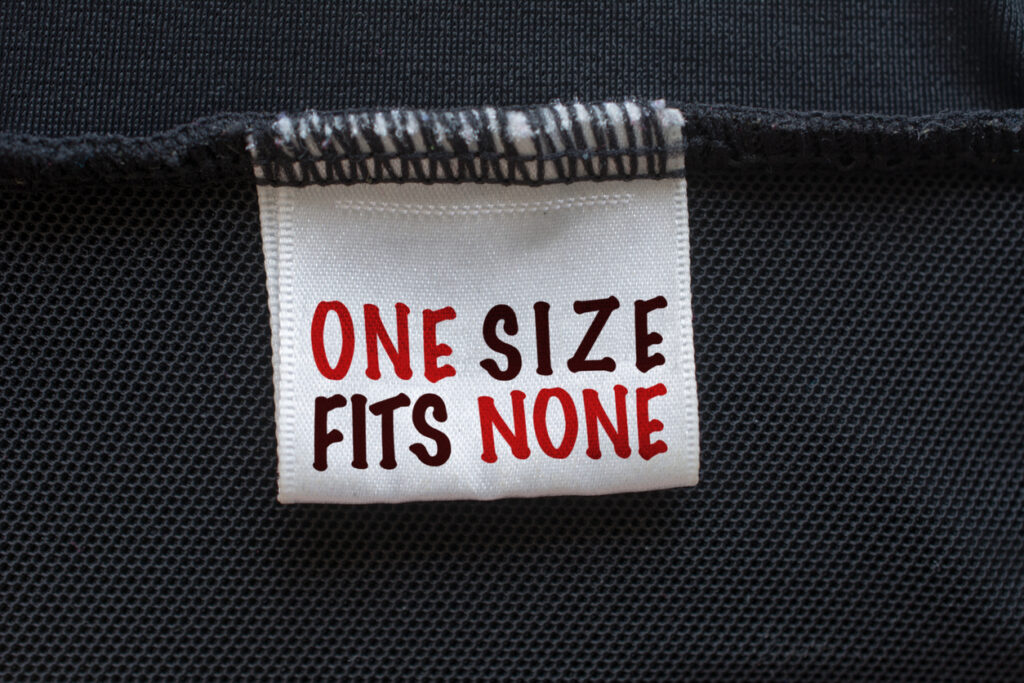Myth: Trickle Down Economics Works Since the days of Ronald Reagan, many have promoted the…

Performative DEI and the DEI Industrial Complex
Breaking the Cycle and Identifying New Pathways to Change

There is a call to action that most employers would be remiss to ignore. The current climate makes no secret of the real-time demand for diversity, equity and inclusion (DEI) in the workplace. The urgent need for change is palpable.
The pressure to DO SOMETHING is very real. And yet DEI is not something one can DO!
Shifting the DEI Mindset
Diversity, equity and inclusion is a mindset shift with systemic repercussions that echo well beyond the bottom line. Organizations are presented with the not-so-straightforward task of facilitating solutions so it’s understandable when the decision is made to choose a ready-made approach. It’s easy. It checks the boxes. The problem is, this is a hallmark of performative DEI that does nothing but feed the DEI industrial complex. And your employees, customers and everyone you do business with can tell.
Deciding to invest in a custom approach may be the first step towards realigning leadership and employee perceptions about how genuinely DEI is built into your organization, and is a critical step toward approximating real change.
The DEI Industrial Complex and Performative DEI Are Hand-in-hand

When it comes to introducing DEI or DEIB (diversity, equity, inclusion and belonging) to an organization, a popular approach to seeing it through is hiring a DEI consultant selling a one-size-fits all package of solutions.
The expectation is that an hour, a day, or a brief collection of racial sensitivity workshops and unconscious bias training will communicate a company’s dedication to the cause and create an inclusive culture. But there are no standards, consistency, or firm-to-firm accountability in the methods or the efficacy of these one-off interventions.
Leaders Check the DEI Box
Unfortunately, leaders know these “out of the box” solutions aren’t based on much data, if any, and may not even work, but are often seen as “imperfect but better than nothing.” Unsurprisingly this kind of DEI “training” results in a whole lot of nothing.
On the leadership end however, the proverbial box is checked, and the performance of DEI is complete.
Performative DEI is when an organization says all the right things and makes all the right plans to bring DEIB into the company culture without doing the hard work of putting plans into action.
Performative DEI Misses the Mark
DEI “training companies” selling these performative solutions they know don’t work, are afforded yet another opportunity to bill for questionably effective interventions, yet another cycle of the DEI industrial complex.
The DEI industrial complex refers to this self-perpetuating cycle of exploitation between leadership and some DEI providers. Together they fuel the continuation of the inequities they strive to eliminate through buying/providing interventions that don’t work to the detriment of the very population they claim to serve.
Employees End Up Disappointed and Frustrated
Here begins the misalignment of perception. Training might persuade an employee that a culture shift is on the horizon. When change does not happen, the gap broadens. Lower-level marginalized employees are left wondering why they have been invited to sit through yet another training session as the harassment, exclusion and lack of support in the workplace continue.
What does the research on DEI effectiveness say?
Recent Gallup surveys from the spring of 2022 affirm the picture of this unfortunate cycle of performative DEI and a lack of results.
Leaders Rank DEI Effectiveness Higher than Employees
Leadership by and large believed their organization to be actively invested in DEIB change and growth (84%). Meanwhile, less than a third of employees reported their organization as genuinely working towards DEIB-related improvements (31%).
Research conducted by SAI 360 similarly notes that leadership perceives the presence of empowerment and inclusion opportunities at a rate nearly double that of employee perceptions. Research by Spectra Diversity mirrors these findings. When organizations collect data on job roles, those in executive positions typically rank several percentage points higher in their perceptions of management, culture and the 3Ps (policies, practices and procedures) than do those below them in the organization.
Performative DEI Lacks Sincerity
In work by Catalyst, most of the 7,000 persons surveyed experienced their organization’s DEI efforts as lacking in sincerity. This belief could extend to marginalized employees questioning the morality, ethics and trustworthiness of their organization, further widening the perception gap on a whole host of topics.
Perception Differences in DEI Cause a Lack of Trust
The Gallup research showed broad disparities in leadership vs. employee perceptions of respect (60% vs 44% belief that employees feel respected), trust (86% vs 35% belief the company will do the right thing) and caring (65% vs. 24% belief that company cares about their wellbeing).
The DEI Business Case – Just Another Box to Check
To make matters worse, leadership buy-in on DEI all too often comes by way of the assumed benefit to the bottom line, also known as “the business case.” The business case assumption that any diversity hire can bring different experiences and skills and thus more earning power to the table indirectly aligns the diverse employee as a means to an end, a box to check for financial gain rather than a valued individual and contributing member of a team.
In research by Aneeta Rattan, this profits-driven approach was most disquieting to underrepresented job applicants and associated with concerns for potential exclusion, stereotyping and prejudice. These red flags can chase these underrepresented applicants away.
With 80% of Fortune 500 companies citing the business case as its impetus for DEI initiatives on their websites, it is no wonder marginalized employees struggle with believing their company genuinely respects them or cares.
DEI efforts done right “can’t be transactional. “They must be transformational (Smith, 2023),” resulting in both a monetary and a cultural return on investment. A custom approach, based on your unique needs can go much further in completing the work of long-term systemic dismantling and reorganization of power structures, is a preferred approach most inclined to facilitate real and lasting results.
Diversity, Equity and Inclusion are Core Values
The inclusion of diversity as a company core value shouldn’t require explanation or justification any more than integrity or compassion. Diversity, equity, inclusion and belongingness are standalone values.
Companies that understand this recognize DEIB cannot operate in a vacuum, but instead must be woven into the fabric of their business model. The companies that get it, really get it, and aren’t just acting on pressures from society or shareholders.
Instead, they have a genuine invested interest in their marginalized employees and act out of care and concern. When DEI is built into the fabric of what an organization stands for, there is easy navigation of missteps, the right people want to work for them, and everyone feels stronger as an integral member of the team.
Performative DEI and the DEI industrial complex fail to embrace the real work of change through a holistic and interconnected approach. Recognizing that diversity is a standalone value lays the foundation for taking steps toward “work that works (Zheng, 2022).”
How can leadership develop more authentic, effective DEI initiatives?
Communication: Listen
A successful DEI initiative must begin with open communication. It is imperative for leadership to create an open door and ongoing invitation to listen to management and employee concerns about DEI.
The same Gallup research highlighting so many misaligned perceptions actually documented employee and management agreement that management confidence in discussing DEI topics needs to improve. These conversations are an opportunity to identify company-specific challenges that can be addressed in a customized DEI initiative.
Communication: Share
Communication is two-way. Detailing the full extent of the company’s dedication to DEI, including current goals, and progress to date is key to helping close the perceptions gap.
Let management and employees know how you are turning their concerns into action plans. When management perceives a commitment to DEI from leadership they will feel more prepared to field lower-level employee requests and concerns.
Communicate your commitment to diversity authentically, through all of your content and communications, not just in a neatly typed up press release hidden on your website.
Consult a Specialist
With a clear picture of the organizations’ blind spots, employee concerns and differences in perception, leadership can then begin to tackle company-specific action items with an informed understanding of what is going well, and where they need to grow. We often find, even if there’s an in house DEI committee or team responsible for this work, a specialist can sometimes help.
The right kind of DEI service provider aims to coach an organization through changes in thinking and behavior that will ultimately result in lasting and repeatable outcomes. They can help your organization address challenges by directing customized education, training and strategy development to relevant persons at every level of a business’s hierarchy.
At Spectra Diversity our DEI facilitators, coaches and consultants have years of experience, and work to customize their solutions to deal with issues identified in assessments and other means. Placing greater value and attention on interviewing, vetting, and maintaining a working relationship with a specialist will edge out the cookie-cutter, highly-visible influencer types and raise the bar in your organization to meet the needs of your unique culture.
Collect Data, Compare Outcomes
The best-intentioned training fueled by company-wide concerns can become yet another example of the DEI industrial complex in the absence of plans to quantify and perpetuate the desired outcomes. Outcome measures should provide tangible, quantifiable data that can be used to establish baselines, targets, maintenance and growth over time. They can alert an organization to areas in need of repeat attention over time, and they communicate to service provider specialists just how effective their interventions have proven to be.
 Genuine Investment in Growth is the Goal.
Genuine Investment in Growth is the Goal.
Performative DEI and the DEI industrial complex cycle will continue in a world that values quick impersonal solutions over long-term customized strategies that address the specific concerns of individual companies.
Diverse people beget diverse thinking and diverse behavior. These individuals influence innovative collaborative teamwork through their ability to navigate obstacles and opportunities from a different perspective.
Top companies recognize the balance between diverse demographics and customized coaching as a proactive approach to exceeding business growth expectations across the board. They seek out this cultural growth just as much as financial, are perceived as genuinely invested in DEIB initiatives and successfully shrink the gap between employee and leadership perception of meaningful change.
DEI References
Benton & Bradford, “Why DEI Efforts Fail: You Can’t “Do” Diversity,” Richard Smith.
The Glass Hammer, “Truth Check-In: Is Your DEI Performative or Genuine?,” Aimee Hansen, July 2022.
Harvard Business Review, “Research: Where Employees Think Companies’ DEIB Efforts Are Failing,” Jeremie Brecheisen, March 2023.
Harvard Business Review, “The Failure of the DEI-Industrial Complex,” Lily Zheng, December 2022.




